March 19th, 2019 — 11:51am
Pachinko by Min Jin Lee
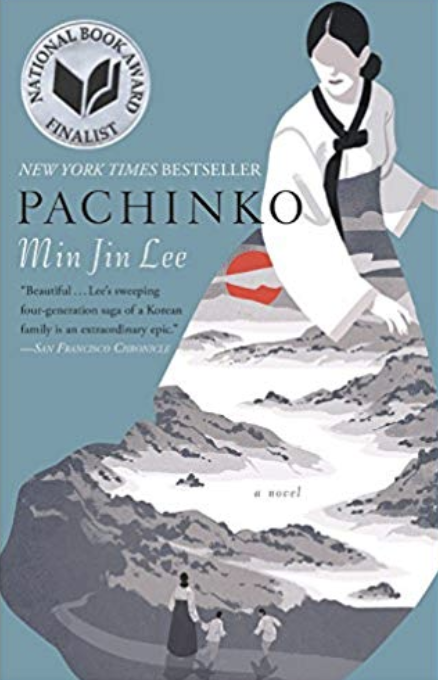 This book introduces the reader to the story of Koreans who migrated from Japan shortly before the outbreak of World War II. It also traces the occupation of Korea by the Japanese prior to this time and follows a family who lived in Japan for four generations. This book tells the story of discrimination against the Koreans by the Japanese. Through the depiction of various characters, the reader learns about family values, the role of women, religious beliefs and the impact of culture on the lives of this multi-generational Korean family.
This book introduces the reader to the story of Koreans who migrated from Japan shortly before the outbreak of World War II. It also traces the occupation of Korea by the Japanese prior to this time and follows a family who lived in Japan for four generations. This book tells the story of discrimination against the Koreans by the Japanese. Through the depiction of various characters, the reader learns about family values, the role of women, religious beliefs and the impact of culture on the lives of this multi-generational Korean family.
The book takes the reader on an interesting journey which not only studies all aspects of the personalities and values of the characters, but also paints a very vivid picture of the bustling street markets in Korea as well as the life in the universities in Japan. There is also a very interesting and revealing story about “Pachinko”, a gambling parlor game that is common and also the connection to the criminal underworld of the people who run these games.
This is a good read which pulls back the curtain and reveals the lives of people who we may not have had the opportunity to meet and understand.
Your comments are always welcome below
If you wish to purchase this book on Amazon, please click here
Comment » | FG - Fiction General, FH - Fiction Historical
December 25th, 2014 — 5:52pm
Unbroken by Laura Hillenbrand– I read this book and wrote this review prior to seeing the movie by the same name. I do plan to see it and will review it in FilmRap.net.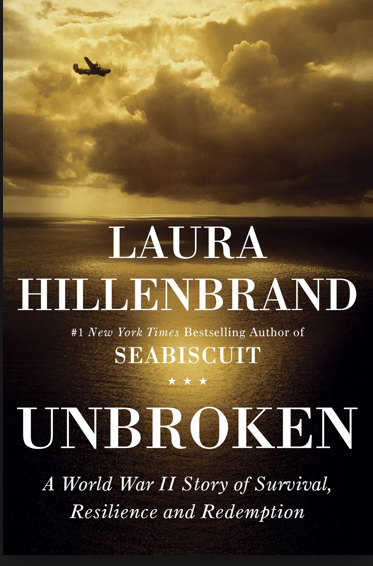 (click here to see review)
(click here to see review)
Louie Zampereini was an Italian-American boy from a poor family who was raised in Torrance, California. He was a rough and tumble kid who had a propensity for stealing things and getting into trouble. He was fast on his feet and ultimately developed into a record breaking track star who participated in the 1936 Olympics in Berlin, Germany. When World War II came about he signed up for the Army Air Force and became a bombardier. Early in the war his plane on a mission crash-landed in the Pacific Ocean where he and two other airman survived in rafts for 47 days as they drifted 2000 miles. During this time they battled starvation, dehydration, hungry sharks and storms as well as Japanese planes that strafed them with machinegun fire. If you think this was bad you should see what happened after they were rescued at sea…by the Japanese and made prisoners of war (although they were never treated according to the Geneva Convention rules for POWs). We see how things were absolutely terrible and how demeaning the treatment of American Prisoners was, ironically clearly much worse than the German Nazis reportedly dealt with their American captives. Louis was apparently treated much more savagely once he was recognized as an Olympic track star.
Being a member of the Silent Generation and having come of age in the decade following WWII, I grew up as a kid reading all sorts of stories and seeing all the movies about this war. Even now as an older guy I am still drawn to a book such as this one. I am sorry to say that reading about the awful treatment by the Japanese of the helpless American prisoners, my old negative prejudiced feelings about the Japanese people were awakened. I know these are irrational and are related to issues from a previous generation. Although a few kind guards were mentioned, there clearly was, at that time, an institutionalized culture of cruel, vicious treatment of the Americans who were starved, tortured and made to do slave labor. We see these atrocities through the eyes of Zamperini who was officially considered dead by his government although his family seemed to have never given up hope for him. We trace his ordeal as he is moved to various prison camps and was never registered with the Red Cross as a POW although that was the usual procedure mostly followed by the Japanese who nevertheless hid their maltreatment of their captives.
The book does not end with his liberation at the end of the war. It follows Zamperini’s reintegration into civilization and his seeming resilience but also his very dark and destructive periods, which were almost as bad as you can imagine. The author Laura Hillenbrand, who previously wrote the best seller Seabiscuit had access to diaries, newspaper articles, radio and television interviews and a gigantic trove of people to interview who knew Zamperini in the various phases of his life including those who were imprisoned with him and close family members. She also had the opportunity to interview Zamperini himself more than 75 times and became quite close to him before he died in July of 2014 at the age of 97.
At times the book seems overly repetitious. Perhaps it felt that way because it was so painful. I am not giving away the ending because the title clearly does that but this book is also about the human spirit. As an outsider who didn’t live through his ordeal and didn’t live through this time as an adult, I can only try to get into Louis’ head through this book. When we try to do this, there is a tendency for us to be traumatized. At one point in the book we learn that recently there was a commemorative memorial made by the local Japanese people at the site of one of the camps at which Zamperini spent much of his time. It honored and remembered the prisoners who were there, many of them who had died there. We are also told that there are pictures of six birds flying in the sky as symbols of the memory for 6 of the prison guards who were tried as war criminals and executed! On the day that I am writing this review there is a front page article in the New York Times that discusses the current Japanese Prime Minister Abe and his hope to bring about a change in the Japanese constitution which was written post war by the Americans and forbids Japan from ever going to war again. Time marches on.
1 comment » | B - Biography, HI - History
August 20th, 2010 — 7:47pm
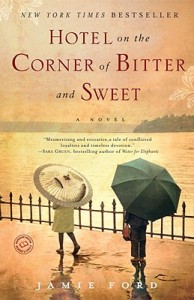 Prior to reading this book, I had recently read Shanghai Girls by Lisa See which is about two Chinese sisters and chronicles their lives from the horror of the Japanese invasion in China to the painful unfair discrimination which they encountered in this country during and after World War II. Hotel on the Corner of Bitter and Sweet
Prior to reading this book, I had recently read Shanghai Girls by Lisa See which is about two Chinese sisters and chronicles their lives from the horror of the Japanese invasion in China to the painful unfair discrimination which they encountered in this country during and after World War II. Hotel on the Corner of Bitter and Sweet which is debut novel by Jamie Ford in a sense compliments the other book as it provides insight into the fate of the Japanese living in the United States approximately during this time period. Most Americans, of course know very little about this page of our history. This novel provides a window into what happened when the Japanese families were ripped from their homes and jobs and put in what were called internment camps by the government but prison camps by the people who were involuntarily taken there. While the story was quite poignant and sweet, it did not have the complexity of story and the depth of characters, which I thought was present in Lisa See’s book.
which is debut novel by Jamie Ford in a sense compliments the other book as it provides insight into the fate of the Japanese living in the United States approximately during this time period. Most Americans, of course know very little about this page of our history. This novel provides a window into what happened when the Japanese families were ripped from their homes and jobs and put in what were called internment camps by the government but prison camps by the people who were involuntarily taken there. While the story was quite poignant and sweet, it did not have the complexity of story and the depth of characters, which I thought was present in Lisa See’s book.
The story is mostly told through, through the eyes of Henry, a Chinese American who was born in the United States to immigrant parents who expected him to speak English although they could not and maintain their Chinese heritage which included a hatred of the Japanese who had attacked their native country. As a youngster he was sent to an upper class white school in Seattle on a scholarship, which meant that he had to help out in the kitchen at lunchtime and clean the erasers after school. While doing this job he meets Keiko, a Japanese girl, also born in the US and sent to this school by her proud parents. They work together, become good friend and even develop an emotional bond which becomes disrupted when she, her family and her entire Japanese community is whisked away almost overnight. The attempt of these barely teenagers to hold on to each other in these impossible circumstances is quite touching. The Hotel Panama is one of the last remnants of the Japanese community and had bordered on the still thriving Chinese community. It is the place where so many of the artifacts of the now transported Japanese Americans have become eternally stored symbolizing their buried memories.
We don’t really get to know these characters of this book as fully formed multi-determined individuals. We are actually introduced to Henry at a point in life where his wife has died and his son is ready to get married. We know very little about him other than that he has this burning memory of his early love at age 12-13 which is locked in his soul. We learn about this phase of his life as chapters flashback to this time .
The mood of the book is unfulfilled forbidden love which perhaps symbolizes the unfavorable lives of the community of people where their most prized possessions reside in this Hotel of Bitter and Sweet also known as the Hotel Panama. The sadness of loss is also played out in the somewhat lengthy discussion of the Nursing Home death of Henry’s s childhood close friend Sheldon. When the movie of this book comes out , the musical score will be the soulful sound of legendary Seattle jazz musician Oscar Holden which was an important part of this story and played in the background for most of the telling of this tale.
Comment » | FH - Fiction Historical
 This book introduces the reader to the story of Koreans who migrated from Japan shortly before the outbreak of World War II. It also traces the occupation of Korea by the Japanese prior to this time and follows a family who lived in Japan for four generations. This book tells the story of discrimination against the Koreans by the Japanese. Through the depiction of various characters, the reader learns about family values, the role of women, religious beliefs and the impact of culture on the lives of this multi-generational Korean family.
This book introduces the reader to the story of Koreans who migrated from Japan shortly before the outbreak of World War II. It also traces the occupation of Korea by the Japanese prior to this time and follows a family who lived in Japan for four generations. This book tells the story of discrimination against the Koreans by the Japanese. Through the depiction of various characters, the reader learns about family values, the role of women, religious beliefs and the impact of culture on the lives of this multi-generational Korean family.





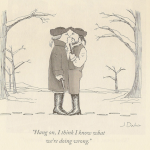
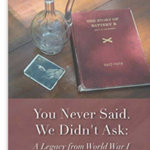
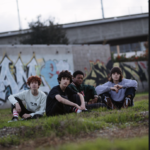






 Prior to reading this book, I had recently read Shanghai Girls by Lisa See which is about two Chinese sisters and chronicles their lives from the horror of the Japanese invasion in China to the painful unfair discrimination which they encountered in this country during and after World War II.
Prior to reading this book, I had recently read Shanghai Girls by Lisa See which is about two Chinese sisters and chronicles their lives from the horror of the Japanese invasion in China to the painful unfair discrimination which they encountered in this country during and after World War II.